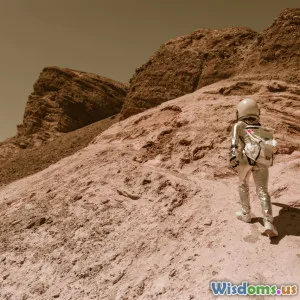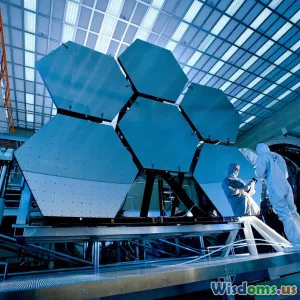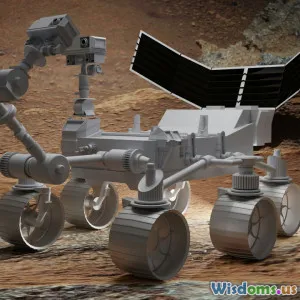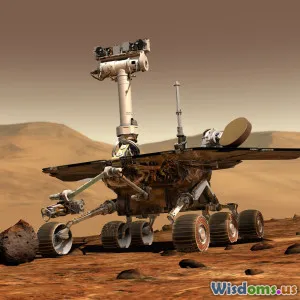
Life on Mars: Challenges and Innovations
7 min read Explore the challenges and groundbreaking innovations shaping the future of life on Mars. (0 Reviews)
Life on Mars: Challenges and Innovations
Human fascination with Mars has evolved from myth and science fiction to a tangible goal for space exploration. Mars represents both an extreme environment and a new frontier, pushing the boundaries of technology and human endurance. Realizing the dream of life on Mars requires overcoming formidable challenges while fostering innovations that could ultimately transform not only Martian habitation but also life on Earth.
The Harsh Reality of Martian Environment
Extreme Climate and Atmosphere
Mars is a cold desert planet with an average surface temperature of -80 degrees Fahrenheit (-62 degrees Celsius), though it can vary widely from -195 F to 70 F at the equator during summer days. Its thin atmosphere, composed of about 95% carbon dioxide, offers scant protection from solar and cosmic radiation and insufficient oxygen for human breathing.
Furthermore, the atmospheric pressure on Mars is less than 1% of Earth's, which complicates liquid water retention and poses a threat to human survival without protective suits or habitats. Dust storms, sometimes planet-wide and lasting for months, can drastically reduce solar power efficiency.
Radiation Exposure
Unlike Earth, Mars lacks a protective magnetic field and thick atmosphere, exposing inhabitants to cosmic rays and solar particle events. NASA studies estimate that radiation doses on Mars can be as high as 0.67 millisieverts per day—roughly 200 times the average daily exposure on Earth. This level increases the risks of cancer, acute radiation sickness, and degenerative diseases for settlers.
Resource Scarcity
Mars has no readily accessible water sources in liquid form; the most available water is in frozen ice caps or within subsurface permafrost. Additionally, traditional farming tools are ineffective due to the Martian soil's perchlorate toxicity and unique mineral composition.
Engineering the Future: Innovations Enabling Mars Habitation
Habitat Solutions: Protecting Life
Innovators like NASA's Habitat Demonstration Unit and private ventures such as SpaceX envision pressurized habitats equipped with radiation shielding. Concepts include underground living spaces carved from Martian rock to reduce radiation doses and 3D-printed habitats using Martian regolith.
A recent real-world example is the MOXIE experiment aboard NASA's Perseverance rover, successfully creating oxygen from Martian carbon dioxide—an indispensable technology for breathable air and rocket fuel production.
Life Support Systems and Sustainability
Closed-loop life support systems recycling air, water, and waste are essential. Designs incorporate hydroponics and aeroponics to grow food, alleviating lifelong supply dependencies from Earth. Experiments aboard the International Space Station, like the Veggie plant-growth project, provide vital data on cultivating crops under space conditions.
Water extraction technologies targeting the extraction of water molecules bound in minerals and ice are being developed. Companies like Honeybee Robotics have designed drills capable of accessing subsurface ice deposits.
Psychological and Social Innovations
Isolation and confinement make psychological health a critical concern. Strategies include virtual reality environments simulating Earth settings, robust communication protocols with Earth, and group dynamics training to maintain crew cohesion.
Future missions may incorporate AI companions to support mental health and cognitive functioning, inspired by successful Earth analogs such as the HI-SEAS Mars simulation habitat in Hawaii.
The Role of Robotics and Artificial Intelligence
Robots and AI will pave the way before humans arrive, performing scouting, habitat construction, and resource extraction. The Perseverance rover's success gathering samples and analyzing the Martian environment guides mission planning.
Robotic systems can autonomously build infrastructure using in-situ resources, dramatically reducing launch mass and mission costs. AI algorithms optimize energy consumption and habitat maintenance, ensuring sustainable human presence.
Ethical and Legal Considerations
Colonizing Mars raises questions about planetary protection to prevent contamination of possible Martian ecosystems and challenges terrestrial legal frameworks about ownership and governance of extraterrestrial territories. International dialogue is critical to develop policies resembling the Antarctic Treaty but adapted to space.
Conclusion: Mars as Humanity's Next Leap
The quest to establish life on Mars embodies humanity's spirit of adventure and ingenuity. Each challenge—be it harsh climate, radiation, resources, or psychological factors—has spurred technological breakthroughs and innovative strategies. With ongoing missions, partnerships between governmental agencies and private companies, and steady advancements in science and engineering, the dream of living on Mars is transitioning from science fiction to an attainable future.
Understanding life on Mars not only propels space exploration but also prompts innovations that address global challenges on Earth, urging us to rethink sustainability in degenerate environments. As Carl Sagan aptly said, “The Mars we seek is still friends and foes alike. But in meeting it, we learn about ourselves.”
The red planet awaits—bringing promises and challenges alike for the next chapters of human exploration.
Rate the Post
User Reviews
Popular Posts




















